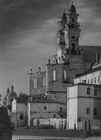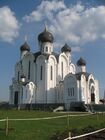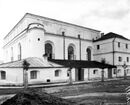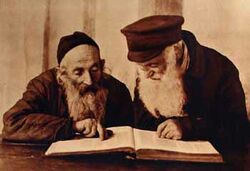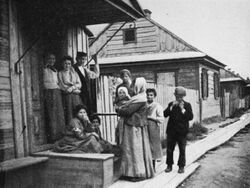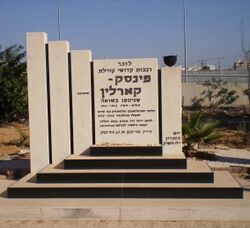پنسك
پنسك
Pinsk | |
|---|---|
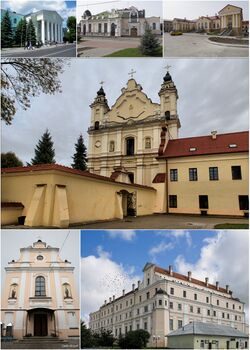 أعلى: جامعة پولسكي الحكومية، Paliessie Drama Theater, Palace of Butrymowicz, وسط:Pinsk Blessed Virgin Mary's Cathedral, أسفل:Pinsk Saint Barbara Church, Pinsky Jesuit Collegium (all item from left to right) | |
| الإحداثيات: 52°06′55″N 26°06′11″E / 52.11528°N 26.10306°E | |
| البلد | |
| المنطقة | منطقة برست |
| District | Pinsk District |
| Mentioned | 1097 |
| المساحة | |
| • الإجمالي | 51٫48 كم² (19٫88 ميل²) |
| المنسوب | 141 m (463 ft) |
| التعداد (2013) | |
| • الإجمالي | 136٬096 ▲ |
| [1] | |
| منطقة التوقيت | UTC+3 (MSK) |
| Postal codes | 225700, 225710, 225716, 225745 |
| مفتاح الهاتف | +375 165 |
| License plate | 1 |
| الموقع الإلكتروني | Official website |
پنسك (بالبيلاروسية: Пі́нск؛ روسية: Пи́нск [pʲin̪s̪k]؛ Pinsk ؛ بالپولندية: Pińsk ؛ باليديشية: פינסק) هي مدينة تقع في منطقة برست في بلاروس، في منطقة پولسيا، عند التقاء Pina River and the Pripyat River. The region was known as the Marsh of Pinsk and is southwest of Minsk. The population is 138,415.[2]
The historic city has a restored city centre, with two-story buildings from the 19th century and the early 20th century. The centre has become an active place for youths of all ages with summer theme parks and a new association football stadium, which houses the city's football club, FC Volna Pinsk.
. . . . . . . . . . . . . . . . . . . . . . . . . . . . . . . . . . . . . . . . . . . . . . . . . . . . . . . . . . . . . . . . . . . . . . . . . . . . . . . . . . . . . . . . . . . . . . . . . . . . . . . . . . . . . . . . . . . . . . . . . . . . . . . . . . . . . . . . . . . . . . . . . . . . . . . . . . . . . . . . . . . . . . . .
التاريخ
خط زمني حتى ح.ع.1
- In the 9th and 10th centuries, the town of Pinsk was majority Lithuanian[3]
- 1097 - the first mention of Pinsk
- 1241 - transfer of the Orthodox diocese from Turov
- 1316 - after this date, Pinsk was incorporated into the Grand Duchy of Lithuania
- 1396 - a Catholic church and a Franciscan monastery were erected
- 1523 - Pinsk becomes a royal city, first owned by Queen Bona
- 1569 - Pinsk becomes a seat of the poviat
- 1581 - king Stephen Báthory grants Pinsk city rights
- 1642-1646 - Saint Andrew Bobola stayed in the Jesuit monastery in Pinsk and nearby, conducting evangelistic activity
- 1648 - rebellion of the city and admission of Cossack forces under the command of Colonel Maxim Hładki. The slaughter of burghers not of the Orthodox religion. The assault of Janusz Radziwiłł's troops on the city, under the command of the hetman Hrehory Mirski of about 1200-1300 people, ended with the capture of the city. The city was burned to the ground and about 1/3 - 1/2 of the inhabitants were killed (it is estimated that on the eve of the Khmelnytsky Uprising, Pinsk had about 10,000 inhabitants)
- 1655 - Russians and Cossacks attacked the city and murdered many inhabitants.
- 1657 - in mid-May Zdanowicz's cossacks (about 2,000) destroyed the city and murdered many Roman Catholics. Jesuits, incl. Fr. Simon Maffon and Saint Andrew Bobola
- 1660 - Cossacks attacked Pinsk, robbed a Jesuit college and church, and murdered, among others Fr. Eustachy Piliński
- 1662 - return of the Jesuits to Pinsk, fire of the monastery after a year
- 1666 - foundation of the Dominican monastery
- 1690 - foundation of the Karolin settlement by Jan Karol Dolski
- 1695 - construction of a church and castle in Carolina by Michał Serwacy Wiśniowiecki
- 1706 - from May 5 to June 3. The capture of Pinsk by King of Sweden Charles XII. Blowing up the castle of Michał Serwacy Wiśniowiecki
- 1707 - the occupation of Pinsk by the army of General Halast and General Hołowina
- 1709–1710 and in 1716 - a great epidemic with thousands of victims
- 1717 - construction of the Bernardine monastery
- 1734 - construction of a Carmelite monastery
- 1756 - construction of the Mariavite Order [de] monastery
- 1767 - construction of the Ogiński Channel
- 1775 - construction of the Royal Canal
- 1793 - the Second Partition of the Commonwealth. Pinsk now belongs to Russian Empire.
- 1795 - establishment of the Catholic diocese of Pinsk (previously Pinsk was in the diocese of Lutsk)
- 1799 - the incorporation of Karolina into Pinsk
- 1796 - the liquidation of the Uniate diocese of Pinsk
- 1799 - liquidation of the Pinsk Catholic diocese (it was moved to Minsk)
- 1812 - in July, Pinsk was taken by Napoleon's army
- 1850 - a candle and soap factory was established
- 1882 - a railway line was brought from Żabinka and a match factory was opened
- 1885 - construction of a river shipyard in Leszcze
- 1907–1909 - a provincial circle of the Polish Education Association in Minsk operated in the city, which organized lectures on Polish literature and vocabulary, which, according to a report by the Russian police, "increased Polish national consciousness".
- 1909 - during the local elections 22 Russians, 7 Poles, 2 Jews and 1 representative of other nationalities were elected to the city council
- 1915 - Russian authorities abandon the city escaping from advancing German forces
الحرب العالمية الثانية والحرب الپولندية السوڤيتية
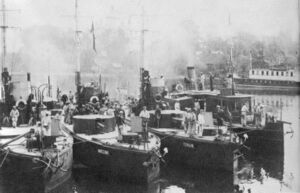
المعالم
اليهود في پنسك
المناخ
| Climate data for پنسك (1991–2020, extremes 1875–present) | |||||||||||||
|---|---|---|---|---|---|---|---|---|---|---|---|---|---|
| Month | Jan | Feb | Mar | Apr | May | Jun | Jul | Aug | Sep | Oct | Nov | Dec | Year |
| Record high °C (°F) | 11.2 (52.2) |
16.4 (61.5) |
22.3 (72.1) |
30.2 (86.4) |
32.9 (91.2) |
36.1 (97.0) |
36.1 (97.0) |
36.3 (97.3) |
35.5 (95.9) |
26.7 (80.1) |
20.3 (68.5) |
12.8 (55.0) |
36.3 (97.3) |
| Mean daily maximum °C (°F) | −0.7 (30.7) |
0.9 (33.6) |
6.4 (43.5) |
14.3 (57.7) |
20.2 (68.4) |
23.4 (74.1) |
25.3 (77.5) |
24.8 (76.6) |
18.8 (65.8) |
12.2 (54.0) |
5.3 (41.5) |
0.7 (33.3) |
12.6 (54.7) |
| Daily mean °C (°F) | −3.0 (26.6) |
−2.0 (28.4) |
2.2 (36.0) |
9.0 (48.2) |
14.6 (58.3) |
18.0 (64.4) |
19.9 (67.8) |
19.0 (66.2) |
13.6 (56.5) |
7.9 (46.2) |
2.7 (36.9) |
−1.6 (29.1) |
8.4 (47.1) |
| Mean daily minimum °C (°F) | −5.3 (22.5) |
−4.7 (23.5) |
−1.4 (29.5) |
4.1 (39.4) |
9.1 (48.4) |
12.7 (54.9) |
14.6 (58.3) |
13.6 (56.5) |
9.1 (48.4) |
4.4 (39.9) |
0.4 (32.7) |
−3.7 (25.3) |
4.4 (39.9) |
| Record low °C (°F) | −34.7 (−30.5) |
−29.9 (−21.8) |
−25.7 (−14.3) |
−9.0 (15.8) |
−3.1 (26.4) |
1.4 (34.5) |
4.5 (40.1) |
1.1 (34.0) |
−4.5 (23.9) |
−12.4 (9.7) |
−23.3 (−9.9) |
−28.0 (−18.4) |
−34.7 (−30.5) |
| Average precipitation mm (inches) | 39 (1.5) |
32 (1.3) |
36 (1.4) |
35 (1.4) |
59 (2.3) |
74 (2.9) |
92 (3.6) |
57 (2.2) |
52 (2.0) |
46 (1.8) |
45 (1.8) |
44 (1.7) |
611 (24.1) |
| Average extreme snow depth cm (inches) | 5 (2.0) |
6 (2.4) |
3 (1.2) |
0 (0) |
0 (0) |
0 (0) |
0 (0) |
0 (0) |
0 (0) |
0 (0) |
1 (0.4) |
4 (1.6) |
6 (2.4) |
| Average rainy days | 7 | 6 | 8 | 11 | 13 | 14 | 14 | 11 | 12 | 12 | 11 | 8 | 127 |
| Average snowy days | 14 | 14 | 9 | 2 | 0 | 0 | 0 | 0 | 0 | 1 | 6 | 13 | 59 |
| Average relative humidity (%) | 85 | 82 | 77 | 68 | 67 | 71 | 72 | 73 | 78 | 81 | 86 | 88 | 77 |
| Source: Pogoda.ru.net[4] | |||||||||||||
. . . . . . . . . . . . . . . . . . . . . . . . . . . . . . . . . . . . . . . . . . . . . . . . . . . . . . . . . . . . . . . . . . . . . . . . . . . . . . . . . . . . . . . . . . . . . . . . . . . . . . . . . . . . . . . . . . . . . . . . . . . . . . . . . . . . . . . . . . . . . . . . . . . . . . . . . . . . . . . . . . . . . . . .
سكان بارزون
- Narymunt, (1277-1348), Prince of Pinsk
- Bona Sforza, (1494-1557), Queen consort of Poland and Grand Duchess consort of Lithuania, Princess of Pinsk
- Adam Naruszewicz (1733–1796), Polish-Lithuanian poet, historian, bishop
- Matheus Butrymowicz (1745-1814), Polish-Lithuanian statesman, reformer of Polesye
- Aaron of Pinsk (died 1841), rabbi
- Napoleon Orda (1807-1883), Polish-Lithuanian musician, pianist, composer and artist
- Vintsent Dunin-Martsinkyevich, (1808-1884), Belarusian writer, poet, dramatist and social activist, author of play Pinskaya shlyakhta'
- Helena Skirmunt (1827-1874), Polesian painter and sculptor
- Baruch Epstein (1860–1941), bookkeeper, rabbi and prolific Jewish scholar, best known for his Torah Temimah commentary on the Torah
- Ivan Zholtovsky (1867-1959), Soviet architect and educator
- Raman Skirmunt (1868-1939), Belarusian and Polesian statesman, aristocrat and landlord
- Chaim Weizmann (1874–1952), first president of Israel, born in Motal, near Pinsk and educated in Pinsk
- Sir Isaac Shoenberg (1880–1963), electrical engineer born in Pinsk, principal inventor of the first high-definition television system, as used by the BBC
- Leo Zeitlin (1884–1930), composer, born in Pinsk before studying in Odessa and later moving to the U.S.A.
- Golda Meir (1898–1978), fourth prime minister of Israel, born in Kiev, lived two years of her childhood in Pinsk
- Simon Kuznets (1901–1985), 1971 Nobel laureate in economics
- Theodore Odrach (1912-1964), Ukrainian and Polesian writer of novels, short stories and memoirs
- Kazimierz Świątek (1914-2011), Cardinal of the Roman Catholic Church, Metropolitan Archbishop of Minsk-Mohilev and Apostolic Administrator of Pinsk
- Semyon Furman (1920–1978), Chess grandmaster and trainer of World Champion Anatoly Karpov
- Ryszard Kapuściński (1932–2007), Polish writer and reporter
- Yauhen Shatokhin (1947-2012), Belarusian painter and political activist
- Chaim Kanievsky (1928–2022), Prominent Rabbi
- Izya Shlosberg (1950–), Jewish American artist, born in Pinsk and lived in Pinsk for 44 years
- William Moses Feldman, child physiologist, born in Pinsk
- parents of Ralph Lauren, American fashion designer lived in Pinsk before moving to the U.S.A
- Vladimir Chub (1948–), governor of Rostov Oblast in Russia
- Igor Kolb (1977?–), principal dancer of Mariinsky Ballet
- Olga Govortsova, (1988–) Belarusian tennis player
- Andrzej Kondratiuk (1936–2016), Polish film director, screenwriter, actor, and cinematographer
- Sławomir Rawicz (1915–2004), Polish Army lieutenant, claimed to have walked from Siberia to India during World War II
- Shabsay Moshkovsky (1895-1982), noted physician, research scientist and malariologist
المراجع
- ^ "Belarus - The regions of the Republic of Belarus as well as all cities and urban settlements of more than 10,000 inhabitants". City Population. Retrieved 2014-04-11.
- ^ "Пинск попал в десятку крупнейших городов Беларуси" (in الروسية). Retrieved 2020-11-11.
- ^ Greenbaum, Masha (1995). The Jews of Lithuania: A History of a Remarkable Community 1316-1945. Jerusalem: Gefen. p. 2. ISBN 9789652291325.
- ^ "Погода и Климат – Климат Пинск" (in الروسية). Weather and Climate (Погода и климат). Retrieved 8 November 2021.
للاستزادة
- Mordechai Nadav (2008) The Jews of Pinsk, 1506–1880; edited by Mark Jay Mirsky and Moshe Rosman; translated by Moshe Rosman and Faigie Tropper. Stanford, Calif: Stanford University Press,
- (In Belarusian, Russian and English) T. A. Khvagina (2007) Pinsk and Its Surroundings, Minsk Vysheysha shkola, ISBN 978-985-06-1419-3,
- (In Belarusian, Russian and English) T. A. Khvagina (2004) Pinsk: A Fairy Tale of Polessye, Minsk Vysheysha shkola, ISBN 985-06-0836-6,
- (In Belarusian, Russian and English) T. A. Khvagina (2005) POLESYE from the Bug to the Ubort, Minsk Vysheysha shkola, ISBN 985-06-1153-7.
وصلات خارجية
- Yad Yisroel - Pinsk
- "The Jews of Pinsk" by Jeremy Rosen. The Algemeiner, July 28, 2013.
- Jewish Community in Pinsk on Virtual Shtetl
- Photos on Radzima.org
- "The city of Pinsk, Belarus" by Tatyana Khvagina and Oleg Babinets
- "Pinsk", Jewish Encyclopedia
- Images of the Assumption Cathedral
- Image of the Jesuit Collegium
- Virtual Guide to Belarus: Pinsk
- News from Pinsk
- قالب:JewishGen-LocalityPage
- Pages using gadget WikiMiniAtlas
- CS1 الروسية-language sources (ru)
- Short description is different from Wikidata
- Articles with hatnote templates targeting a nonexistent page
- Articles containing بلاروسية-language text
- Articles containing روسية-language text
- Coordinates on Wikidata
- Pages using Lang-xx templates
- Articles containing يديشية-language text
- پنسك
- Brest Litovsk Voivodeship
- Cities in Belarus
- Holocaust locations in Belarus
- Pinsky Uyezd
- Polesie Voivodeship
- Populated places established in the 11th century
- Populated places in Brest Region
- شتتل




